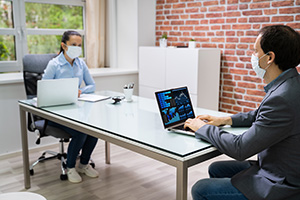Returning to the Workplace: Adapting Workspaces and Operations to Keep Employees Safe
 COVID-19 has changed nearly every aspect of our daily lives, from how we work and commute, to how we teach our children, shop and connect with our communities. And while the majority of us are looking forward to a swift return to normalcy, we must acknowledge that the world we return to post-pandemic will not be the same one we left.
COVID-19 has changed nearly every aspect of our daily lives, from how we work and commute, to how we teach our children, shop and connect with our communities. And while the majority of us are looking forward to a swift return to normalcy, we must acknowledge that the world we return to post-pandemic will not be the same one we left.
One of the most notable impacts we’re likely to encounter on a daily basis will be a difference in our physical workplaces. With social distancing guidelines still at the top of recommended preventative action from the CDC, we can expect to see fundamental differences in the way our workplaces are organized, staffed and operated.
Reorganizing Work Stations
Before COVID-19, tightly packed cubicles and collaborative workspaces were commonplace, but few, if any, of these set-ups meet the CDC guidelines for social distancing. This puts returning workers at greater risk. In addition to increasing both the frequency and intensity of office cleaning, institutions may want to consider reorganizing workspaces wherever possible to accommodate for the recommended six feet of social distance. Suggestions for keeping employees mindful of social distancing include increasing signage and visual indicators of distance, removing excessive furniture and enclosing workstations where possible.
Staggering Work Schedules
In addition to changing up the office layout, or where reorganization is not feasible, employers may also want to consider adopting staggered schedules for their workforce. Such schedules would include different start and stop times either for individuals or smaller groups of employees, and allowing for staff rotation and continuation of telework to the extent possible. Staggering schedules can help lower employees’ risk of exposure at traffic-heavy points of entry and exit, such as reception areas and elevators, while a decrease in overall office population through offering rotating remote work can drastically improve an organization’s ability to maintain appropriate social distancing.
Assessing Communal Spaces and Groups
Many state and local guidelines have recommended that groups should be limited to 10 persons or less, if they must meet at all. The most immediate effects on the workplace will of course be on conferences, meetings, presentations and educational opportunities. But considerations must also be made for in-office social events and communal spaces — office parties, potlucks, buffet style cafeterias, fitness centers and shared break areas should all be assessed for the potential risk they pose to employees.
In less than a year, COVID-19 has drastically changed the higher ed landscape. Already, we talk in pre-pandemic and post-pandemic timelines, comparing before and after, even as the “after” continues to evolve. It’s important that we continue to evolve as well by proactively and regularly assessing the risks present in our workspaces and taking effective mitigating action.
Related resources:
Returning to the Workplace: Employee Expectations
Return-to-Campus Planning (CUPA-HR COVID-19 Resources)
CUPA-HR’s Workforce Planning Tool (CUPA-HR members-only resource)
Checking in With Ira Shepard: Employee Health and Safety on Return to Campus
Houston Community College’s Manager Toolkit: Preparing for the New Norm
COVID-19 Planning Guide and Self-Assessment for Higher Education (OpenSmartEdu)


